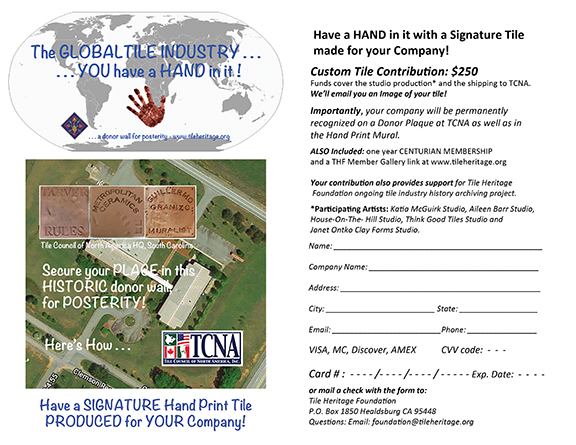E-News Fall 2019
we're social … connect to Tile Heritage ……. share this site... Thank you!
Founded in July 1987 Tile Heritage is celebrating its 32nd anniversary this year. Supporters like YOU… industry sponsors, members, major contributors, grantors … everyone… have made possible the continued fulfillment of the Foundation's mission to Document and Preserve tile history in the US both past and present.
E-News for Fall 2019
Here's What's below
Monterey Mural Lives On
Taste the Water … see the World
"Rising Native Flora"
Mosaic Seat Wall in Mill Valley
HAVE A HAND IN IT!
E-News Fall 2019 as a PDF
E- News prior to 2010
by Ron Wagner
On Monday October 24, 2018 at the corner of Del Monte Avenue and Pacific Street in Monterey, California, cars drove by honking gleefully as the Monterey Mural done by my father, Guillermo Wagner Granizo, was being reinstalled on the wall at the Monterey Conference Center.
My father created several murals around California as well as various locations around the world. This mural was originally commissioned by the City of Monterey in 1983. Like many of Granizo’s city murals, this mural depicts the history of the Monterey area including 150 various scenes that tell this city’s story starting from the time the land was occupied by Native Americans including the time of the Spanish Settlers and up until Monterey became a popular tourist destination. Details such as fishing, scuba diving, golf and nature watching are all incorporated into its story. In the far upper right-hand corner of the mural flies a hot air balloon with the faces of Bing Crosby, Samuel Morse and John Steinbeck, all famous people who contributed to the development of this popular California coastline city. If you look closely you can even find Dennis the Menace whose comic series was created in Monterey. Here is a LINK to a bigger image of the mural.
How it all came down
This 11 by 45-foot mural became an icon of the Monterey area. In 2015 the decision was made to remove the mural and all 633 pieces of tile from its location for three years while the Conference Center was being re-built. This project was extensive and as the mural was removed from the wall, fear of loss prevailed. One wondered if it would ever be seen again. Over this three-year period, I often contacted Dennis Copeland of the City of Monterey, who was a champion of this project, and he reassured me that while the mural would return, it might find a new home in a new location within the city. About two years into the wait, Dennis contacted me again to tell me the building was being finished, and he hoped to see the reinstallation within months at its original site. As all important projects go there were delays, but finally in November of 2018 the mural was reinstalled, and the City of Monterey held a dedication with the mayor and other important city officials and friends to honor its return.
The process of removing the mural was amazing. Thanks to Architectural Resources Group (ARG), conservation services in San Francisco, the mural came down piece by piece with only 65 pieces sustaining damage. ARG repaired each tile to perfection and kept the mural carefully stored while reconstruction of the building took place. Once the decision to reinstall the mural at the Conference Center, C. L. Frost Inc. of Sand City, California, tile installers for 90 plus years, did a spectacular job putting the mural back up in place. The people employed by both these companies were professional craftsmen who treated the mural like it was their own. Some tiles needed restoration . . . . Masterful!
The Monterey Mural was a significant accomplishment for my dad and one that was very important to him personally. He put his heart, soul and humor into this mural. As you walk around and observe all of the stories that he had incorporated into the mural, you will be in awe of his talent and humor. The mural remains a beautiful piece of public art, and like all his works, one made for people to enjoy. Here is a LINK to a bigger image of the mural.
Editor’s Note: Miracles DO happen! With the responsibility of removing this mural on your hands, having ONE tile break in the process might be manageable but 65! Imagine the care that must be involved in just securing each of the tiny pieces, keeping the pieces for each broken tile separate, reconfiguring what goes where when back in the studio, and finally the skill involved in adhering the pieces together and then masking the repairs! ARG has done a masterful job!
A portion of the original Monterey Mural designed and meticulously glazed by Granizoon Stonelight 9” x 12” pre-fired tiles.
"Rising Native Flora"
Mosaic Seat Wall for Marin County Parks
from Wilma Wyss
Wilma Wyss puts some finishing touches on her floral masterpiece.
This 300 square foot mosaic was installed on an existing circular concrete bench on the Mill Valley Sausalito Path. The materials are high fired tiles, as well as some glass accent tiles. There are close to 100 different colors of tile from various manufacturers, primarily from McIntyre Tile in Healdsburg, CA, Heath Ceramics in Sausalito, CA as well as Dal Tile's Natural Hues. The entire mosaic was created with hand tools to cut and shape the tile.
The seat wall is approached from all sides and seen from great distances, so a bold design approach was key. I found inspiration in graffiti art for the graphic style of outlining the plants and in using bold colors. Marin County Parks provided me with a list of appropriate native plants, which I researched, then choose ones that I found visually striking.
The plants are highly stylized, often just using a portion of the plant, such as the stamen, leaf or bud. The stamped name tiles were created by Bevilacqua Studio. Marshland plants like Goldenthread (Cuscuta pacifica), Marsh rosemary (Limonium californicum), and Inland saltgrass (Distichlis spicata) animate the interior of the curved wall. You may find these plants while exploring nearby Bothin Marsh. A sense of time is evoked with a gradation of colored high fired tile and glass tiles that represent the sunrise and sunset. This placement is aligned with the actual sunrise and sunset during the equinox. Here is a LINK to a bigger picture!
The outer side of the seat wall depicts a year in time, with blooming native plants and rolling hills. Notice the change in the colors of the hills corresponding with the time of year. Two days of on-site community workshops gave adults and children the opportunity to create areas depicting hills. Design, fabrication and installation by Wilma Wyss with a wonderful team of assistants and volunteers.
Directions: From Hwy. 101, north of the Golden Gate, exit at E. Blithedale Ave.
Go west and turn south on Camino Alto, then east to the end of Sycamore Ave. at Bay Front Park.
“There I was, on my hands and knees…”
from Gary Warkentin, Craven Manor Pottery
The library’s architect, William Hartley Dennett of Boston, was familiar with Henry Mercer’s work through the Society of Arts and Crafts in Boston, where he and his wife were active members and where Mercer’s tiles were promoted from the beginning of his business in 1898. Dennett placed an order for the tiles with the Moravian Pottery and Tile Works in January 1902. His first order for a fireplace mantel (now in the Reference Room) is composed of 10 “English” wall tiles with a medieval design (see at left), each measuring 3 ¾” square.
The second Moravian fireplace mantel, designed for the Children’s Room and now in the Local History Room, is composed of a facing of 30 “English” wall tiles (see at right). The cost of the tiles totaled $145.75 and the bill was paid on July 1, 1902. The record of this transaction is recorded in MPTW Papers, Ledger Book Vol. 1, page 158, bill 1 in the collection of the Moravian Pottery and Tile Works in Pennsylvania. Here is a LINK to bigger images of the fireplaces.
Information courtesy of Derby Public Library.
. . . HAVE A HAND IN IT ! Click HERE
or on the image below for an on-line fillable form !
![]()
![]()
![]()
![]()
![]()
![]()
Tile Heritage embraces its Industry Sponsors! LINK HERE!
. . . or on the image
